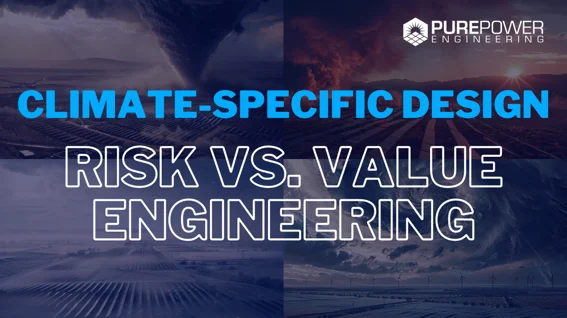Mother Nature offers an endless supply of clean solar energy, yet she also presents challenges that can threaten your solar array. As your Owner’s Engineer, Pure Power ensures that the systems you invest in are built to withstand the harshest conditions they’ll encounter over their 25-plus-year lifespan, without unnecessary overspending.
It’s not enough to design for average conditions. We focus on preparing for the worst Mother Nature can dish out. While vendors and installers might feel pressured to cut costs, sometimes they push their designs too far, transferring hidden risks to you. As your Owner’s Engineer, our job is to review every aspect of the project—equipment, design, installation, climate, and location—to make sure you enjoy the benefits of value engineering without taking on extra risks.

To ensure your PV systems last and perform optimally, it’s essential to pay attention to environmental factors that could stress components. Long-term performance depends on accounting for these exposures. Common environmental conditions impacting design include snow and frost, coastal high winds, seismic activity, and extreme heat and UV radiation.
### Snow and Frost Considerations
In areas prone to snow and frost, structural and performance concerns must be addressed.
**Structural Issues:** Ground-mounted systems in snowy regions often need to be elevated to allow snow to shed properly. Typically, these structures require three feet of clearance above the ground, compared to the usual 18 to 20 inches. Fixed-tilt systems are particularly vulnerable to heavy snow loads, whereas single-axis trackers, which adjust throughout the day, face fewer problems. A detailed geotechnical report is vital here, ensuring the design accounts for snow-related forces accurately. Frost effects, like foundation heaving, also need careful consideration.
**Performance Issues:** Even in tracker-mounted systems, ignoring the performance impact of snow cover is unacceptable. We avoid relying on unvalidated proprietary models and instead prefer the Marion snow loss model, which is backed by extensive scientific research and recognized by the NREL.
### Coastal High Wind Considerations
Coastal environments aren’t just windy—they’re also prone to flooding during hurricanes.
**Wind Mitigation:** High wind speeds significantly affect structural design, especially in tracker systems. Wind stow strategies and stow angles are critical. Some trackers depend on electricity to reach stow positions, making power loss a significant issue. Ideally, we prefer systems capable of surviving hurricanes without needing redundant systems.
**Flood Mitigation:** Hurricanes bring torrential rain, so elevating mounting structures is key to reducing flood risks. Electrical equipment and wiring should also be raised for protection.

### Seismic Considerations
In seismically active areas, the potential for earthquakes drives structural design decisions, particularly for low-slope roofs and ballasted ground mounts.
**Roof Applications:** Non-anchored systems face unique challenges due to horizontal forces. Ballasted systems rely on friction and weight, but increasing weight means more ballast and possibly roof reinforcement. Anchoring can be a cost-effective alternative.
**Ground-Mount Applications:** Driven-pile foundations don’t need modifications, but floating ballasted systems may not be cost-effective in seismic zones. Developers should weigh the cost of ballasted foundations early in the process.
### High Heat and UV Considerations
Unlike structural concerns, high heat and UV exposure affect system longevity and performance.
**UV Degradation:** Components like wiring hardware, labels, and plastic enclosures degrade faster in high-UV environments. Strategic specifications and protection from sunlight can help mitigate this.
**Thermal Derating:** Inverter placement is crucial in hot climates. Central inverters handle higher temperatures better than string inverters. Shading options and strategic placements can extend equipment life.
### Tornado Design Considerations
For areas prone to tornadoes, robust structural designs are necessary. Systems must withstand extreme winds and flying debris.
**Structural Reinforcement:** Mounting structures and anchoring systems must be reinforced. Ground-mounted systems require deeper foundations, while roof-mounted systems need additional anchoring points.
**Aerodynamic Design:** Streamlined shapes and protective covers reduce wind resistance, minimizing damage.
With these considerations in mind, your solar and storage systems will be prepared for any natural challenge.
Korean Car Auto Camshaft Position Sensor
Here you can find the related products in Camshaft Sensor, we are professional manufacturer of Camshaft Position Sensor, Car Camshaft Sensor, Auto Camshaft Position Sensor, Engine Camshaft Position Sensor, CMP Sensor . We focused on international export product development, production and sales. We have improved quality control processes of Camshaft Position Sensor to ensure each export qualified product.
If you want to know more about the products in Camshaft Position Sensor, please click the product details to view parameters, models, pictures, prices and other information about Camshaft Position Sensor.
Whatever you are a group or individual, we will do our best to provide you with accurate and comprehensive message about Camshaft Position Sensor!
If you want to know more about the products in Camshaft Position Sensor, please click the product details to view parameters, models, pictures, prices and other information about Camshaft Position Sensor.
Whatever you are a group or individual, we will do our best to provide you with accurate and comprehensive message about Camshaft Position Sensor!
Camshaft Position Sensor, Auto Camshaft Position Sensor, Engine Camshaft Position Sensor, Auto Camshaft Sensor, Car Camshaft Sensor
Guangzhou Taixin Auto parts Trading Co., Ltd. , https://www.hyundai-autopart.com